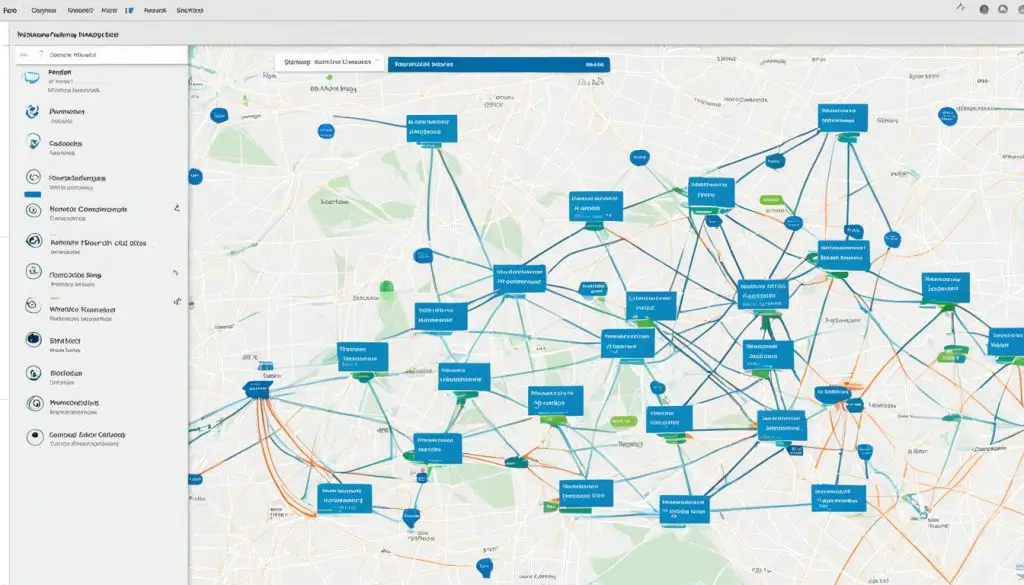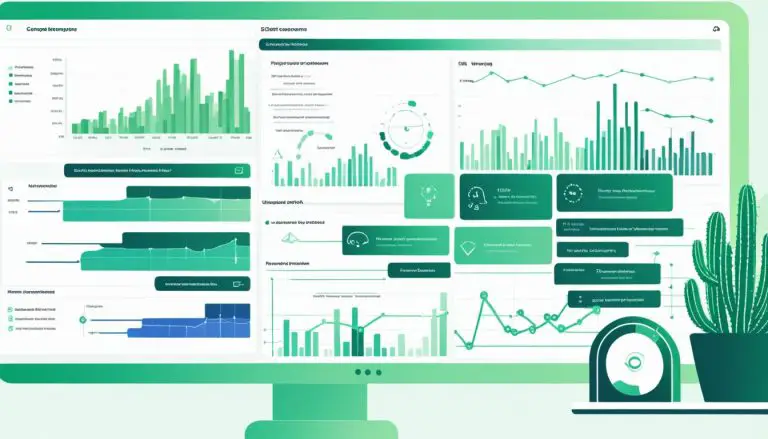LibreNMS vs. Nagios: A Comparative Analysis
When it comes to network monitoring, two popular names come to mind: LibreNMS and Nagios. But which one is the better choice for your organization? Is there a clear winner between these open-source monitoring tools? Let’s dive deep into the world of network management software and explore the strengths and weaknesses of LibreNMS and Nagios. Are you ready to find out the truth behind this ongoing debate?
Key Takeaways:
- LibreNMS and Nagios are both powerful open-source network monitoring solutions.
- LibreNMS offers a user-friendly interface, customizable alerting, and is suitable for organizations of all sizes.
- Nagios XI provides extensive monitoring capabilities, IT infrastructure monitoring, and offers dedicated support.
- Consider your specific network monitoring requirements, scalability needs, and cost considerations when choosing between the two.
- Both LibreNMS and Nagios find applications in industries such as telecommunications, education, and healthcare.
The Importance of Network Monitoring
Network monitoring plays a crucial role in effective network management, ensuring the smooth operation and optimal performance of your network infrastructure. It involves continuous monitoring and analysis of network activity, including bandwidth usage, server uptime, device health, and network traffic.
Effective network monitoring allows IT teams to proactively detect and resolve issues, minimizing downtime and ensuring high network availability. By monitoring network performance in real-time, you can identify bottlenecks, optimize capacity planning and resource allocation, and prevent critical network issues.
Furthermore, network monitoring provides valuable insights into network usage patterns, allowing you to make informed decisions regarding network design and upgrades. By analyzing network data, you can optimize your network infrastructure to meet the growing demands of your users.
Investing in network monitoring is essential for maintaining a stable and efficient network environment. It enables you to detect and troubleshoot issues promptly, ensuring that your network performs optimally and supports your business operations.
Comparing LibreNMS and Nagios Features
When it comes to network monitoring, both LibreNMS and Nagios offer a range of features and capabilities that cater to different network management needs. Let’s take a closer look at the key features provided by each tool.
LibreNMS Features
- Auto-discovery: LibreNMS automates network discovery using SNMP, making it easy to map devices and their connections.
- Customizable alerting system: Users can configure complex alerting rules based on device health, traffic thresholds, and connectivity issues.
- Distributed polling: LibreNMS supports distributed polling, allowing efficient monitoring of large networks.
- Wide device support: It can monitor a wide range of network devices, making it suitable for diverse network infrastructures.
- Plugins and integrations: LibreNMS offers the ability to extend functionality through plugins and integrations with other tools.
- Web-based interface: The user-friendly web interface provides easy access to network information and monitoring capabilities.
- API access: Users can access network data and perform various operations through the API.
- Geographical maps: LibreNMS provides geographical maps to visualize network infrastructure and monitor device locations.
- Customizable dashboards: Users can create personalized dashboards to display relevant network monitoring information.
Nagios Features
- Extensive IT infrastructure monitoring: Nagios XI enables comprehensive monitoring of various network infrastructure components, including applications, services, operating systems, and network protocols.
- Proactivity: Nagios XI offers predictive analysis and proactive monitoring to identify potential issues before they impact network performance.
- Multiple integration options: Users can seamlessly integrate Nagios XI with other applications, allowing for centralized monitoring and control.
- Complete visibility: Nagios XI provides a centralized view of network operations, allowing users to monitor the entire infrastructure from a single interface.
- User-friendly interface: The intuitive interface of Nagios XI makes it easy to navigate and access monitoring features.
- Customizable layouts: Users can personalize the monitoring experience by configuring layouts that suit their specific needs.
- Configuration snapshots: Nagios XI allows users to save and compare configurations for easy troubleshooting and change management.
- Advanced user management: It offers fine-grained control over user permissions and access levels.
- Role-based web interface: Nagios XI provides customizable roles, ensuring that users have access to the information they need.
Choosing between LibreNMS and Nagios depends on the specific network monitoring requirements of an organization. While LibreNMS excels in features such as auto-discovery and wide device support, Nagios XI offers extensive infrastructure monitoring and proactive analysis. Consider the scalability, flexibility, and compatibility with existing infrastructure when evaluating these tools for your network monitoring needs.
Network Performance Monitoring with LibreNMS and Nagios
Both LibreNMS and Nagios offer robust network performance monitoring capabilities, allowing organizations to ensure the optimal performance and reliability of their network infrastructure. By monitoring essential network performance metrics, organizations can proactively identify and address issues, optimize network resource allocation, and enhance overall network performance and user experience.
Real-time Visibility into Network Performance
LibreNMS provides real-time visibility into network performance, enabling organizations to monitor key performance metrics such as network performance metrics, bandwidth utilization, latency, packet loss, and response times. With detailed analytics and reports, IT teams can gain insights into network performance analysis and identify network performance optimization opportunities. By actively monitoring network performance with LibreNMS, organizations can quickly detect and resolve performance bottlenecks, minimizing network downtime and ensuring a smooth user experience.
Comprehensive Monitoring of Network Infrastructure
Nagios XI offers comprehensive monitoring of all network infrastructure components, including applications, services, operating systems, and network protocols. It allows users to track performance metrics of individual devices, generate trends, and create capacity planning charts. By monitoring the entire network infrastructure with Nagios XI, organizations can gain network performance metrics insights and proactively address potential issues before they impact network performance. This level of monitoring ensures network uptime, reduces troubleshooting time, and improves overall network reliability.
Optimizing Network Resource Allocation
Monitoring network performance with both LibreNMS and Nagios enables organizations to optimize network performance metrics network resource allocation effectively. By analyzing network performance data, IT teams can identify underutilized resources, predict future capacity requirements, and make informed decisions about network design and upgrades. This ensures that network resources are allocated efficiently, minimizing wastage and allowing the network to support the growing demands of users.
Enhancing Network Performance and User Experience
Network performance monitoring with LibreNMS and Nagios is vital for ensuring optimal network performance and enhancing the user experience. By proactively monitoring network performance, organizations can identify and resolve performance issues before they impact users. This proactive approach minimizes network downtime, improves application responsiveness, and ensures a seamless user experience. Moreover, optimizing network performance leads to increased productivity and satisfaction among users, fostering a positive working environment.
In conclusion, both LibreNMS and Nagios provide powerful network performance monitoring capabilities that enable organizations to closely monitor network performance, optimize resource allocation, and enhance overall network reliability. By leveraging the insights provided by these tools, organizations can proactively manage network issues, ensure optimal network performance, and deliver an exceptional user experience.
Network Alerting System in LibreNMS and Nagios
Both LibreNMS and Nagios provide powerful network alerting systems to promptly notify IT teams of network issues and anomalies.
In LibreNMS, users can create customized alerting rules based on various conditions, such as device health, traffic thresholds, and connectivity problems. It supports multiple alert notification channels, including email and SMS, ensuring that IT teams receive critical network alert notifications in a timely manner. This proactive network monitoring approach enables organizations to minimize downtime and swiftly address network issues.
Nagios XI also offers a customizable alerting system that allows users to configure alerts based on specific network events and thresholds. It provides comprehensive alerting capabilities, including event correlation and escalation, ensuring that critical network alerts are promptly addressed. Nagios XI’s alert management system helps organizations maintain a proactive network monitoring strategy, enhancing network stability and performance.
By leveraging these robust network alerting systems in LibreNMS and Nagios, organizations can establish a proactive monitoring approach. This enables them to minimize network downtime, promptly respond to network issues, and ensure uninterrupted network operations.

Scalability and Flexibility of LibreNMS and Nagios
Both LibreNMS and Nagios offer scalable and flexible network monitoring solutions that cater to organizations of different sizes and network complexities. These tools provide the necessary infrastructure to meet the growing demands of network monitoring in today’s digital landscape.
Scalability:
LibreNMS is designed to be easily scalable, accommodating networks of all sizes. With its distributed polling feature, organizations can distribute monitoring tasks across multiple servers, ensuring efficient monitoring of larger networks. This allows for seamless scalability as the network expands. Additionally, LibreNMS offers wide device support, enabling the monitoring of various network hardware and operating systems. This adaptability further enhances its scalability, making it suitable for organizations with diverse network environments.
Nagios XI also provides scalability for monitoring large networks. It offers multiple integration options, allowing users to seamlessly integrate the monitoring tool with in-house and third-party applications. This scalability ensures that organizations can effectively monitor their network infrastructure as it grows and changes over time, providing a stable and reliable monitoring solution.
Flexibility:
Flexibility is another key aspect of LibreNMS and Nagios’ network monitoring solutions. LibreNMS offers a range of features that can be customized to meet specific monitoring needs. These include a customizable alerting system, a web-based interface for easy access, and geographical maps for visualizing network performance. LibreNMS also provides API access and supports plugins and integrations, allowing users to extend its functionality and tailor it to their unique requirements.
Nagios XI’s flexible configuration capabilities give users complete control over their monitoring experience. It enables the customization of layouts, configuration snapshots, and advanced user management. This flexibility allows organizations to adapt the monitoring tool to their specific network monitoring needs, ensuring that they can monitor and manage their network infrastructure efficiently.
By combining scalability and flexibility, both LibreNMS and Nagios offer robust network monitoring solutions that can meet the evolving needs of organizations. Whether it’s monitoring a small network or a complex infrastructure, these tools provide the necessary functionality to ensure effective network monitoring.
Cost and Support Considerations
When considering network monitoring solutions, one important factor to evaluate is the cost. While network monitoring is crucial for maintaining a stable and efficient network environment, it’s essential to find a cost-effective solution that meets your organization’s needs.
LibreNMS stands out as a cost-effective option as it is an open-source network monitoring tool. This means that there is no significant upfront investment required to deploy the software. Organizations can access and use LibreNMS without having to purchase a license, making it an attractive choice for budget-conscious businesses. However, it’s important to note that while the software itself is free, there may still be costs associated with hosting, additional hardware, or personnel training.
Support is another crucial aspect to consider when choosing a network monitoring solution. LibreNMS offers community-driven support, which means that there is an active online community of users who can provide assistance, troubleshooting tips, and guidance. The community support helps ensure that organizations can find timely solutions to any issues they may encounter. Additionally, there are various online resources such as forums, blogs, and documentation available, providing valuable insights and guidance to users.
On the other hand, Nagios XI is a commercial network monitoring tool with pricing starting at $1995 for a license. While the licensing cost may seem higher compared to an open-source solution, Nagios XI offers dedicated support as part of its package. The dedicated support ensures that organizations receive timely assistance from Nagios experts when implementing and maintaining the tool. In addition to dedicated support, Nagios XI provides extensive documentation and training options, further enhancing the level of support available to organizations.
When evaluating network monitoring solutions, it’s crucial to assess both the cost and support factors. While LibreNMS presents a cost-effective option through its open-source nature, organizations still need to consider any additional costs incurred. On the other hand, Nagios XI offers a commercial solution with dedicated support, which may be valuable for organizations requiring a higher level of assistance. By thoroughly evaluating the cost and support considerations, organizations can make an informed decision when selecting a network monitoring solution that best fits their requirements.
Industries and Use Cases for LibreNMS and Nagios
Both LibreNMS and Nagios are versatile network monitoring solutions that cater to a wide range of industries, each with unique requirements for network stability and performance. In particular, telecommunications, education, and healthcare sectors can greatly benefit from implementing these powerful network monitoring tools.
Telecommunications:
Network stability and performance are critical in the telecommunications industry to deliver reliable communication services to customers. By implementing LibreNMS or Nagios, telecommunications companies can monitor their network infrastructure to ensure optimal connectivity, minimize downtime, and proactively identify and resolve network issues.
Education:
Network monitoring is essential for educational institutions to support online learning platforms, manage student and faculty connectivity, and prevent cyber threats. The use of LibreNMS or Nagios enables educational institutions to monitor their networks, troubleshoot issues efficiently, and maintain a secure environment for students and staff.
Healthcare:
In the healthcare industry, network monitoring plays a vital role in ensuring the availability and security of patient data, supporting medical devices, and facilitating seamless communication between healthcare professionals. By utilizing LibreNMS or Nagios, healthcare organizations can monitor their network infrastructure, proactively address potential issues, and maintain a stable and secure network environment.
Both LibreNMS and Nagios offer the necessary monitoring capabilities and features to support the unique requirements of these industries. Their robust network monitoring solutions provide valuable insights into network performance, enable proactive troubleshooting, and enhance overall network reliability in telecommunications, education, and healthcare sectors.
Conclusion
In conclusion, both LibreNMS and Nagios are powerful network monitoring solutions that offer unique features and capabilities. LibreNMS provides a comprehensive set of features, including auto-discovery, customizable alerting, and a user-friendly interface, making it suitable for organizations of all sizes. As an open-source solution, LibreNMS eliminates the need for significant upfront costs, making it accessible to a wide range of users.
Nagios XI, on the other hand, offers extensive monitoring capabilities for diverse network infrastructures. With features such as IT infrastructure monitoring, proactivity, and customizable layouts, Nagios XI provides users with the tools they need to effectively monitor their networks. While it is a commercial tool that comes with a price tag, Nagios XI offers dedicated support and training options to ensure organizations receive the necessary assistance for successful implementation and maintenance.
When choosing between LibreNMS and Nagios, organizations should consider their specific network monitoring requirements, scalability needs, cost considerations, and industry use cases. Evaluating these factors will help organizations make an informed decision and choose the right network monitoring software that aligns with their needs and goals. Whether it’s LibreNMS or Nagios, organizations can benefit from these powerful network monitoring tools to ensure the smooth operation and optimal performance of their network infrastructure.
FAQ
What is the primary use case of Juniper Mist Premium Analytics?
What is the most valuable functionality of Juniper Mist Premium Analytics?
What does LibreNMS offer as key features for network monitoring?
What does Nagios XI provide for monitoring?
Why is network monitoring important?
What are the network performance monitoring capabilities of LibreNMS?
What is the network alerting system in Nagios XI?
How scalable and flexible are LibreNMS and Nagios XI?
How cost-effective is LibreNMS as a network monitoring solution?
In which industries can LibreNMS and Nagios XI be used?
- About the Author
- Latest Posts
Mark is a senior content editor at Text-Center.com and has more than 20 years of experience with linux and windows operating systems. He also writes for Biteno.com






